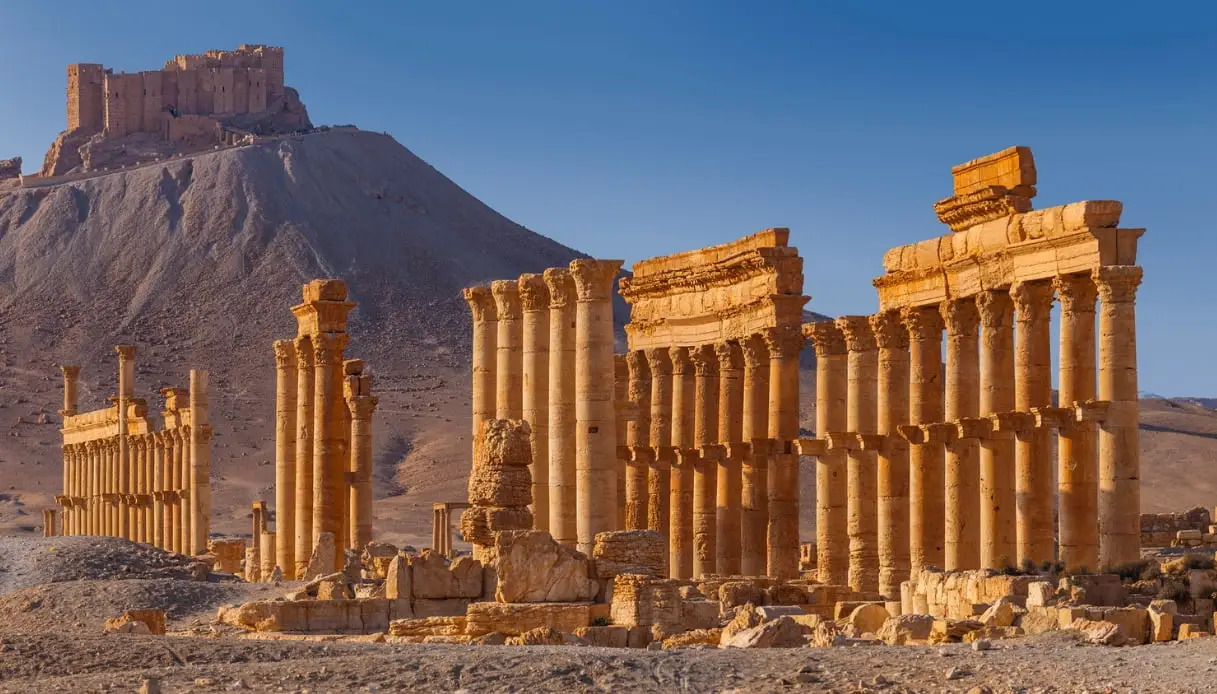
Palmira, a city steeped in a rich history and brimming with fascinating tales, is a hidden gem waiting to be discovered. Located in the heart of a melting pot of cultures and civilizations, Palmira holds an allure that captivates the imagination of both historians and adventurous travelers alike.
This enchanting city, nestled in the lush landscapes of [country], boasts a plethora of remarkable facts and legends that add to its mystique. From ancient landmarks and archaeological sites to vibrant cultural traditions and culinary delights, Palmira offers something for everyone.
In this article, we delve into the depths of Palmira’s past and present, uncovering 37 intriguing facts that will unveil the beauty and allure of this captivating city. So, fasten your seatbelts, and let’s embark on a journey through the captivating wonders of Palmira!
Key Takeaways:
- Palmira, also known as Tadmor, is an ancient city in Syria with a rich history dating back over 2,000 years. It was a vital trading hub along the Silk Road and is renowned for its well-preserved ruins.
- Despite the destruction caused by the Syrian Civil War, efforts are underway to preserve and restore Palmira’s cultural heritage. The city’s unique blend of Roman, Greek, and Persian influences continues to captivate the world.
Palmira is located in the heart of Syria.
Palmira, also known as Tadmor, is an ancient city situated in central Syria, approximately 215 kilometers northeast of the capital city of Damascus.
It is renowned for its well-preserved ruins.
Palmira is celebrated for its UNESCO World Heritage-listed archaeological site, which showcases the remarkable remains of the ancient city dating back to the Roman era.
The city was a vital trading hub.
Palmira flourished as a thriving trading center along the Silk Road, connecting the Roman Empire with various civilizations in the East, including the Parthians, Persians, and Sasanians.
Palmira’s history spans over 2,000 years.
The city has a rich and diverse history that dates back to the 1st century AD when it was established as a caravan oasis by the Palmyrene people.
Queen Zenobia ruled Palmira during its golden age.
Zenobia, a powerful queen, led Palmira to its pinnacle of prosperity and independence in the 3rd century AD, challenging the Roman Empire’s dominance in the region.
Palmira fell under Roman control in 273 AD.
After several failed attempts to resist Roman rule, Palmira was eventually conquered by Emperor Aurelian, leading to the end of Zenobia’s reign.
The architecture in Palmira showcases a fusion of styles.
The structures in Palmira feature a blend of Roman, Greek, and Persian architectural influences, reflecting the city’s cosmopolitan character.
The famous Palmyrene funerary portraits were discovered in Palmira.
Palmyrene funerary portraits, known for their distinctive style, depict the deceased individuals and were frequently displayed in the city’s burial chambers.
The city suffered extensive damage during the Syrian Civil War.
Palmira was severely affected by the ongoing conflict in Syria, with many of its ancient structures being destroyed or damaged by acts of war and terrorism.
The Palmyra Arch of Triumph was reconstructed in London.
In a symbolic gesture, a replica of the Arch of Triumph from Palmira was reconstructed in London’s Trafalgar Square as a testament to preserving cultural heritage.
Palmira is mentioned in ancient texts such as the Bible and the works of Herodotus.
The city has been referenced in various historical writings, including biblical accounts and the writings of the ancient Greek historian Herodotus.
Palmira’s prosperous economy was based on agriculture, trade, and date palm cultivation.
The fertile lands surrounding Palmira allowed for the cultivation of crops and the establishment of a thriving agricultural economy.
The city was a hub of intellectual and cultural exchange.
Palmira attracted scholars, poets, and philosophers from different parts of the world, fostering a vibrant intellectual and cultural environment.
The Temple of Bel was one of Palmira’s most magnificent structures.
The Temple of Bel, dedicated to the Mesopotamian god Bel, was a grand architectural marvel that represented the city’s religious significance.
Palmira was once called the “Bride of the Desert.”
Due to its captivating beauty and historical significance, Palmira earned the nickname “Bride of the Desert,” highlighting its allure and charm.
UNESCO designated Palmira as a World Heritage site in 1980.
The UNESCO recognition emphasizes the importance of preserving and safeguarding Palmira’s unique cultural and historical heritage.
Syrian folklore and traditional music are deeply rooted in Palmira’s cultural heritage.
Palmira has had a profound influence on Syrian folklore and traditional music, with many traditional songs and dances originating from the region.
The city’s underground burial chambers are known as hypogea.
Palmira features an intricate network of underground burial chambers known as hypogea, which served as final resting places for important individuals.
Palmira was a significant center for religious worship.
The city was home to numerous temples, including those dedicated to the gods Baalshamin, Nabu, and Allat, attracting pilgrims from far and wide.
Palmira’s ruins have inspired artists and writers throughout history.
Writers, artists, and photographers have been captivated by the evocative beauty of Palmira’s ruins, immortalizing them in their works of art and literature.
The city’s iconic tetrapylon was reconstructed in 2017.
Following the destruction inflicted by ISIS, efforts were made to rebuild the famous tetrapylon, a monumental structure with four columns.
Palmira’s ancient water system was advanced for its time.
The city had a sophisticated water management system, utilizing aqueducts, cisterns, and wells to ensure a sufficient water supply to its inhabitants.
Palmira was an important stopover for caravans.
The strategic location of Palmira made it a crucial trading post along the Silk Road, offering shelter and supplies to traveling caravans.
The city’s main street was known as the Decumanus Maximus.
The Decumanus Maximus was the central thoroughfare in Palmira, lined with various shops, marketplaces, and public buildings.
Palmira’s ruins extend over an area of more than 100 hectares.
The vast archaeological site of Palmira covers an extensive area, with ruins scattered across more than 100 hectares of land.
The city’s ancient theater could accommodate up to 5,000 spectators.
Palmira’s well-preserved theater was a venue for various performances and could seat a large audience, showcasing the city’s cultural vibrancy.
Palmira’s strategic location made it a target for conquest.
Due to its geographical significance, Palmira witnessed several invasions and conquests throughout its history by various empires and civilizations.
The city’s economy declined following the shift in trade routes.
With the decline of the Silk Road and the emergence of new trade routes, Palmira’s economic significance diminished, leading to its eventual decline.
Palmira’s ruins provide valuable insights into Roman architecture and urban planning.
The architectural features and city layout of Palmira offer valuable information about Roman urban design and engineering techniques.
Palmira is mentioned in the writings of the ancient Roman historian Tacitus.
Tacitus, a renowned Roman historian, mentioned Palmira in his writings, providing valuable historical accounts of the city.
The city’s population was ethnically diverse.
Palmira was home to a diverse population, consisting of Arabs, Romans, Greeks, Persians, and other ethnic groups, contributing to its multicultural identity.
The ruins of Palmira inspired the creation of fantasy worlds in literature and film.
Authors and filmmakers have drawn inspiration from the enigmatic beauty of Palmira’s ruins, incorporating similar settings into their fictional worlds.
Palmira’s ancient city walls extended over several kilometers.
The formidable walls surrounding Palmira extended for several kilometers, providing protection and defense against potential invasions.
The city had an extensive network of tombs and mausoleums.
Palmira’s necropolis contained a vast collection of tombs and mausoleums, reflecting the diverse burial traditions and customs of the region.
The Palmyrene language was a blend of Semitic and Greek influences.
Palmira had its own distinct language, known as Palmyrene, which combined elements of Semitic languages, such as Aramaic, with Greek influences.
Palmira’s ruins were rediscovered in the 17th century.
The ruins of Palmira attracted the attention of European travelers and archaeologists in the 17th century, reigniting interest in the ancient city.
Efforts are underway to preserve and restore Palmira’s cultural heritage.
Despite the challenges posed by the ongoing conflict, initiatives are being undertaken to protect, conserve, and restore Palmira’s priceless archaeological treasures.
These 37 facts about Palmira highlight the city’s historical significance, architectural marvels, and cultural contributions. Despite the destruction that has befallen this ancient site, Palmira continues to captivate the world with its enduring legacy.
Conclusion
In conclusion, Palmira is a fascinating city that is deeply rich in history and culture. From its ancient ruins to its vibrant traditions, this city has so much to offer. Whether you are interested in exploring archaeological sites, indulging in local cuisine, or simply immersing yourself in the unique atmosphere, Palmira is sure to captivate your senses. With its strategic location, Palmira has played a significant role in the history of the region, and its influence can still be felt today. By preserving its heritage and embracing modernity, Palmira continues to be a destination that both educates and inspires visitors. So, if you’re looking for a remarkable travel experience, consider adding Palmira to your list of must-visit cities.
FAQs
Q: How old is Palmira?
A: Palmira dates back to the 3rd millennium BC, making it over 4,000 years old.
Q: Can I visit the ancient ruins in Palmira?
A: Unfortunately, due to recent conflicts, access to the ancient ruins in Palmira is limited for safety reasons. It is recommended to check the latest travel advisories before planning a visit.
Q: Are there any museums in Palmira?
A: Yes, there are several museums in Palmira where you can learn more about its history and view artifacts. Some notable museums include the Palmira Museum and the National Museum of Damascus.
Q: What is the best time to visit Palmira?
A: The best time to visit Palmira is during the spring (March to May) and autumn (September to November) when the weather is pleasant and the crowds are smaller.
Q: Can I try traditional Palmiran cuisine in the city?
A: Yes, Palmira is known for its delicious Middle Eastern cuisine. You can try local specialties such as kebabs, hummus, falafel, and baklava at various restaurants and street food vendors.
Q: Is it safe to travel to Palmira?
A: It is important to check the latest travel advisories before planning a trip to Palmira. Due to the volatile situation in the region, certain areas may be deemed unsafe for travel. It is always recommended to prioritize safety and follow the advice of local authorities.
Please note that the content provided is for illustrative purposes only and should be further customized and verified for accuracy and up-to-date information.
Was this page helpful?
Our commitment to delivering trustworthy and engaging content is at the heart of what we do. Each fact on our site is contributed by real users like you, bringing a wealth of diverse insights and information. To ensure the highest standards of accuracy and reliability, our dedicated editors meticulously review each submission. This process guarantees that the facts we share are not only fascinating but also credible. Trust in our commitment to quality and authenticity as you explore and learn with us.


